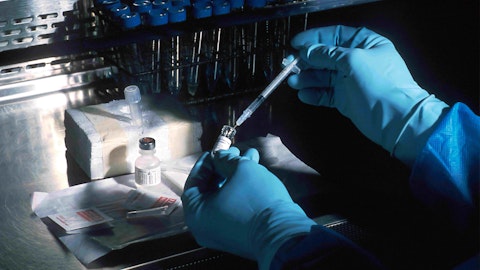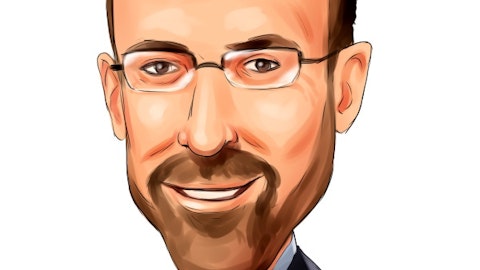Mersana Therapeutics, Inc. (NASDAQ:MRSN) Q4 2022 Earnings Call Transcript February 28, 2023
Operator: Good morning, and welcome to Mersana Therapeutics Fourth Quarter and Year End 2022 Conference Call and Webcast. Currently, all participants are in a listen-only mode. There will be a question-and-answer session at the end of this call. I would now like to turn the call over to Jason Fredette, Senior Vice President, Investor Relations and Corporate Communications. Please proceed.
Jason Fredette: Good afternoon, everyone. Before we begin, please note that this call will contain forward-looking statements within the meaning of federal securities laws. These statements may include, but are not limited to, those related to the therapeutic potential of our product candidates and the potential of our platforms, business strategy, clinical trial designs, initiation, execution and data releases, regulatory plans and objectives, commercial opportunities, collaborations and potential associated payments, operating expenses and cash runway. Each of these forward-looking statements are subject to risks and uncertainties that could cause actual results to differ materially from those projected in such statements.
These risks and uncertainties are discussed in the company’s quarterly report on Form 10-Q filed with the Securities and Exchange Commission on November 7, 2022 and in subsequent SEC filings. Our filings are available at sec.gov and on our website, mersana.com. Except as required by law, we assume no obligation to update forward-looking statements publicly even if new information becomes available in the future. Now with that, let me turn the call over to Anna Protopapas, our President and Chief Executive Officer.
Anna Protopapas: Thank you, Jason. And hello, everyone. Welcome to our conference call. Joining me today with prepared remarks are our Chief Medical Officer, Arvin Yang; and Chief Financial Officer, Brian DeSchuytner. I’m also joined by certain other members of management, who will be available to answer your questions. We are very pleased by the progress we made in 2022. The team’s execution on our UpRi development program, clinical pipeline and business development has helped advances to the task of multiple milestones in 2023 as we seek to further solidify Mersana’s role as both a leader and a partner of choice within the ADC space. Let’s briefly recap some of our most notable accomplishments over the past year. First and foremost is the progress we made in executing on our comprehensive plan to establish UpRi as a foundational medicine in ovarian cancer.
Early in the fourth quarter, we completed enrollment in UPLIFT, our single non-registrational trial in platinum resistant ovarian cancer. We advanced enrollment in UP-NEXT on Phase 3 clinical trial of UpRi as monotherapy maintenance treatment in recurrent platinum-sensitive ovarian cancer. As a reminder, if this data is positive we believe UP-NEXT could serve as the post approval confirmatory trial of UpRi in the U.S., support potential approvals outside the U. S., and support the expansion of UpRi into earlier lines of therapy. More recently, we completed dose escalation and initiated the expansion portion of UPGRADE-A, our Phase 1 trial of UpRi in combination with carboplatin in platinum-sensitive ovarian cancer. Beyond UpRi, we brought XMT-1660 and XMT-2056 into the clinic.
We initiated our Phase 1 trial of 1660, our B7-H4 Dolasynthen product candidate in August. And just last month, we began dosing patients in our Phase 1 trials of XMT-2056, our HER2 Immunosynthen product candidate. Both 1660 and 2056 have distinct pharmacological features and mechanism of action that we believe could strongly differentiate them as we seek to address areas of high unmet medical need. As a result of these efforts, we now have product candidates from all three of our platforms. Dolaflexin, Dolasynthen and Immunosynthen in the clinic generating data. In parallel with our clinical progress, our platforms and product candidates have attracted the interest of numerous potential collaborators. In 2022 alone, we entered into three new collaborations, first with Janssen, then with GSK and more recently in December with Merck KGaA.
We continue to see a high level of interest in ADCs and collaborations remain fundamental to our overall business strategy. In fact, our successes are already leading to initial milestones. In summary, 2022 was a year of tremendous accomplishments and we are excited about what lies ahead in 2023. Before getting into that, let’s have our Chief Medical Officer, Arvin Yang, delve more deeply into our clinical progress. Arvind?
Arvin Yang: Thank you, Anna, and good morning, everyone. As we approach the UPLIFT top line readout, we thought it might be helpful to remind everyone of the significant unmet medical need faced by patients today with platinum-resistant ovarian cancer. These individuals are at the most advanced point of their disease, are heavily pretreated and have a very poor prognosis. Single agent chemotherapy is the only option for most patients. Past trials have consistently shown at an objective response rate or ORR of approximately 12% for single agent chemo in this setting. We’ve enrolled approximately 270 patients in UPLIFT and have included a broad population that includes patients with up to four earlier lines of therapy. The primary endpoint in the trial is the ORR and the NaPi2b positive population.
For context, multiple data sets have shown that a majority of ovarian cancer patients have NaPi2b positive expression. In fact, the largest NaPi2b dataset that has been presented to date includes roughly 400 unique tissue samples and suggest that approximately 59% of the overall ovarian cancer population are NaPi2b positive. The study is designed to exclude the 12% objective response rate for today’s standard of care and the 95% confidence interval. In addition to ORR, we would expect the duration of response or DOR to be evaluated by the FDA along with safety, tolerability, in the overall context of the UPLIFT data. For context, in our dose expansion trial, UpRi generated an ORR of 34% across dose levels in a valuable NaPi2b positive patients with a DOR of approximately five months.
Additionally, in both dose escalation and expansion we saw a differentiated tolerability profile for UpRi without severe ocular toxicity, peripheral neuropathy or neutropenia. Now let’s turn to UP-NEXT, our ongoing Phase 3 trial of UpRi as a monotherapy maintenance treatment and recurrent platinum-sensitive ovarian cancer that is enrolling patients with NaPi2b positive tumors. There is a substantial need for new maintenance treatment options and this need is expanding even further given the recent label restrictions related to PARP inhibitors. Clinical practice today is trending towards patients with BRCA and HRD positive tumors getting PARP inhibitors with or without bevacizumab in the frontline and HRD patients getting bevacizumab in the frontline.
As a result, most patients have exhausted their maintenance treatment options by the time they have recurrent disease, which we believe increases our opportunity with UpRi. UP-NEXT is enrolling patients who have achieved stable disease or better in response to their prior induction chemotherapy. And in recognition of the lack of standard of care in the recurrent maintenance setting, it is randomizing them 2:1 to receive UpRi or placebo. Our primary endpoint for the trial is progression free survival or PFS by blinded independent central review. Now let’s move to our UPGRADE-A Phase 1 trial of UpRi in combination with carboplatin in platinum-sensitive ovarian cancer. Historically, the combination of carboplatin and paclitaxel has served as the standard of care in earlier lines of therapy for platinum sensitive ovarian cancer.
However, this combination has been limited by distinct probability challenges that can include severe neutropenia, peripheral neuropathy and alopecia. We designed UPGRADE-A to investigate the potential benefits of replacing paclitaxel with UpRi in the induction phase of treatment and then continuing UpRi as maintenance monotherapy. Earlier this quarter, we were pleased to begin the dose expansion portion of this trial. And finally, on the clinical front, we are excited to have Phase 1 trials of both XMT-1660 and XMT-2056 now underway. 1660 is our Dolasynthen product candidate targeting B7-H4. We see B7-H4 as a compelling target given its high expression in a variety of tumors and its limited expression in healthy tissue. 1660 is equipped with a precise target optimized drug to antibody ratio of 6 and our DolaLock payload with controlled bystander effect.

Source: Unsplash
And our multicenter Phase 1 trial is investigating this candidate in patients with breast, endometrial and ovarian cancers. In January, we were also excited to initiate our multicenter Phase 1 trial of XMT-2056 our HER2 directed Immunosynthen STING agonist, ADC. Notably, this is the first Immunosynthen candidate to enter the clinic. The trial is designed to investigate 2056 in patients with previously treated advanced or recurrent solid tumors, expressing high and low levels of HER2 such as breast, gastric, colorectal and non-small cell lung cancers. As you may recall, 2056 targets a novel HER2 epitope that is distinct from those targeted by pertuzumab and trastuzumab and it is designed to locally activate STING signaling in both tumor residents immune cells and in tumor cells.
In preclinical models, this candidate has shown compelling efficacy in high and low expressing tumors, both as a monotherapy or in combination with standard of care agents such as HER2 and so with products from all three of our ADC platforms in the clinic, our focus is now firmly on patient enrollment and data generation. With that, let’s turn the call over to our Chief Financial Officer, Brian DeSchuytner for an update on our financials. Brian?
Brian DeSchuytner: Thank you, Arvin. As Anna touched on, business development was a central theme in 2022 as we were able to generate approximately $170 million in upfront capital, which has helped to offset the vast majority of our operating cash needs for the past year. These deals also provide the potential for significant future payments in the form of over $3 billion in potential milestone plus royalties. As Anna mentioned, we’re also already seeing the benefits of our collaborations in the form of discovery milestone revenue. Our most recent success came in the fourth quarter of 2022 as we entered into a research collaboration and commercial license agreement with Merck KGaA to discover novel Immunosynthen ADCs directed against up to two targets.
Under the terms of the agreement, we received a $30 million upfront payment and are eligible to receive up to $800 million in development, regulatory and commercial milestones, as well as tiered royalties up to the low double-digit percentage on net sales. We continue to see a significant amount of interest, both in ADCs and in innate immune modulators and expect business development to remain an important tool within our financing arsenal moving forward. Now turning to our financial highlights from our fourth quarter of 2022. We ended the year with approximately $281 million in cash, cash equivalents and marketable securities up from $178 million at year end 2021. We also have a line of credit available to us and in early 2023 we received Merck’s $30 million upfront payment.
As a result, we are in a strong position financially with the funds required to support our operating plan commitment into the second half of 2024, well past several potential milestones of significance. It should be noted, that our cash runway guidance does not assume any potential milestone payments from our current collaborations or proceeds that we may realize from future collaborations. Net cash used in operating activities was approximately $51.2 million for the fourth quarter of 2022. Collaboration revenue for the fourth quarter of 2022 was $14.7 million compared to an immaterial amount for the same period in 2021. The year-over-year increase was primarily related to our collaboration agreement with Janssen and GSK, including the recognition of an initial discovery milestone under our Janssen agreement.
Research and development expenses for the fourth quarter of 2022 were $45.7 million compared to $37.4 million for the same period in 2021. Non-cash R&D related stock-based compensation expense for the fourth quarter of 2022 was $2.8 million. The year-over-year increase in R&D expenses was primarily related to higher manufacturing and clinical costs related to UpRi, Phase 1 clinical trial start-up activity for XMT-1660 and XMT-2056 and an increase in headcount. General and administrative expenses for the fourth quarter of 2022 were $14.8 million compared to $10.7 million during the same period in 2021. Non-cash G&A related stock-based compensation expense for the fourth quarter of 2022 was $2.5 million. The year-over-year increase in G&A expense was primarily related to an increase in consulting and professional fees and headcount.
Mersana’s net loss for the fourth quarter of 2022 was $44.9 million, compared to a net loss of $49 million, for the same period in 2021. And now, I’ll turn the call back over to Anna for a few closing remarks.
Anna Protopapas: Thanks, Brian and Arvin. We’ve seen an incredibly productive 2022 and are now fast approaching multiple significant milestones. These include our plan to report top line data from UPLIFT in mid-2023 following the major oncology conferences in June. Assuming a positive outcome, our plan would then be to file a BLA around the end of this year. We plan to significantly advance UP-NEXT enrollment and report interim data from UPGRADE-A in the second half of this year. We will advance our Phase 1 trial of 2056 and complete the dose escalation portion of our Phase 1 trial of XMT-1660 this year. And we intend to execute against our existing collaborations, while proactively evaluating new collaboration opportunities that could help to expand the reach of our platforms, maximize the development of product candidates and generate non-dilutive capital.
With our highly differentiated ADC platforms and product candidates, increasing industry recognition and a strong financial position, we’re aiming to make 2023 a transformative year for Mersana and look forward to keeping you updated on our progress. With that, let’s open the call to your questions. Operator, would you please provide the instructions?
See also 10 Best Stocks to Buy and Hold for a Lifetime and 12 Best AI Stocks for 2023.
Q&A Session
Follow Mersana Therapeutics Inc. (NASDAQ:MRSN)
Follow Mersana Therapeutics Inc. (NASDAQ:MRSN)
Receive real-time insider trading and news alerts
Operator: Our first question comes from Jonathan Chang from SVB Securities. Please go ahead. Your line is open.
Jonathan Chang: Good morning. Thanks for taking my questions. With the Phase 3 MIRASOL data expected near term, can you share your latest thoughts on how the results of that study could impact or not your strategy with UpRi in the event of a positive or negative result? And also how should investors be thinking about the overlap of NaPi2b and folate receptor alpha? Thank you.
Anna Protopapas: Thank you, Jonathan. Maybe I can talk a little bit about the overlap and then Arvin can cover any other aspects of your question. So as you are aware, and as we’ve disclosed in multiple data disclosures, NaPi2b high represents the majority of patients. In the largest study we have published together with our diagnostic partner, we looked at 400 unique tissue samples from ovarian cancer patients and demonstrated that 59% of them were NaPi2b high. And that’s consistent with the results from our expansion cohort and other smaller tissue banks studies. We understand from the FDA materials published concurrent with the approval of Merck, that falling high is about 29%. So, there is a small overlap particularly as you take into consideration the fact that these two antigens are not correlated.
So obviously, there’s a very high unmet need in this for these patients, but the overlap between the two antigens is fairly small. Arvin, do you have any comments in terms of the outcome of MIRASOL?
Arvin Yang: Yes, thank you Anna, and Jonathan. So just to follow-up on the question in relationship to if MIRASOL fails or is successful, it does not impact the development pathway for UpRi and UPLIFT in particular, recognizing that the MIRASOL study is actually conducted in a very similar if not identical population to the original psoriasis study in the , whereby our UPLIFT study and our confirmatory study of UP-NEXT is in earlier line population. And it’s also in a smaller population as Anna has just alluded to in relationship to the folate receptor alpha prevalence relative to the NaPi2b prevalence.
Jonathan Chang: Got it, thank you.
Operator: Our next question comes from Ashiq Mubarack from Citi. Please go ahead. Your line is open.
Ashiq Mubarack: Hi, team. Thank you very much for taking my questions. We get a lot of questions on duration of response for UPGRADE. So maybe for UPLIFT, can you comment at all on your expectations for duration relative to the Phase 1? We know the five months number from the Phase 1 was of course, based on a relatively small number of responders that were NaPi2b high. So just wondering how you’re thinking about potential variability of the duration number maybe to the upside or to the downside? Thanks.
Anna Protopapas: Arvin, could you take this?
Arvin Yang: Sure, absolutely. So, no thank you for the question. So, we believe actually that duration of response of five months is quite clinically meaningful. This is based on discussions with our clinical investigators. And as you described, this is what we had seen from our expansion data. Just to further comment on variability, keep in mind that for regulatory reviews, the primary efficacy endpoint is the objective response rate, which we’ve already indicated is that 12% benchmark based off of single agent chemotherapy. Now, certainly, duration of response will also be taken into consideration. But recognizing that it’s a time event driven endpoint, it will be incorporated into the considerations amongst other variables such as the safety and tolerability of the asset.
Ashiq Mubarack: Got it, that’s very helpful. And if I could ask one more, you’ve indicated that the UP-NEXT confirmatory Phase 3 enrollment will be largely completed by the time that the FDA has to make an accelerated approval decision on UpRi. I’m just wondering if you can give any commentary on if the FDA has signed off on this plan or further discussions are necessary? I mean, how confident you are that this strategy meets the sort of usual regulatory criteria for confirmatory trial to be “substantially enrolled”? Thanks.
Anna Protopapas: Ashiq, it’s a good question. And as you’re fully aware, the recent in December indicates that’s where the FDA indicated that we expect the confirmatory trial to be underway at the time of the accelerated approval. There’s no further definition in what underway means. But obviously, as you know, we started UP-NEXT in the second half of last year And therefore, you can expect that we will be well underway by the time there is a decision on UP-NEXT.
Ashiq Mubarack: Perfect. Thanks very much.
Operator: Our next question comes from Asthika Goonewardene from Truist Securities. Please go ahead. Your line is open.
Asthika Goonewardene: Hi, good morning, guys. Thanks for taking my questions. Just wanted to get your thoughts on UP-NEXT, given that you’ll be recruiting kind of a broader spectrum of patients could be second line Immunosynthen or fourth line Immunosynthen. How do you think about the bar to beat the maintenance for UP-NEXT? And then sort of related to Ashiq’s question, we saw with the ImmunoGen experience the FDA also wanted to take a look at some of the data at the MIRASOL study while they were deciding on psoriasis. How do you think the FDA is going to want to see your data for UP-NEXT and what do you think they’ll be looking for? Thanks.
Anna Protopapas: Arvin, can you take this question?
Arvin Yang: Yes, yes, absolutely. So let me start with the first question, just in relationship to what potential bar would be in relationship to the control arm for UP-NEXT. I think the best example or comparison really would come from niraparib in the NOVA study. And this is a trial with a historic PFS in the recurrent platinum-sensitive maintenance setting. And the placebo arm in that study actually demonstrated a PFS of approximately 4.5 months. But also keep in mind a couple of additional variables is that since the time of conduct of that study, the treatment landscape has evolved, There are now more patients that are heavily pre-treated with PARP inhibitors or bevacizumab in an earlier line. And then in addition to that, we include stable disease patients in our eligibility criteria, which were not included in NOVA, so one might reasonably expect the PFS to be lower than the – 4.5 that I just described.
As far as the second question, could you remind me just briefly of the second question about UP-NEXT?





